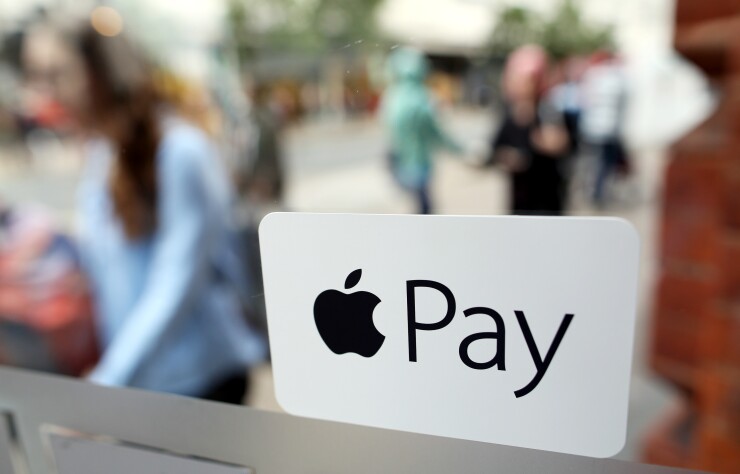
Though Apple took its time moving into the booming buy now/pay later sector with a more conservative approach than many incumbents, Apple Pay Later is rolling out in a way uniquely geared to expand Apple Pay's transaction volume.
One of several features that sets Apple Pay Later apart from rivals is the fact that the Cupertino, California, tech giant will be self-financing its interest-free loans through a new entity, Apple Financing LLC, and loans initially won't exceed $1,000.
But experts say Apple's goal with Apple Pay Later appears to be less about building a huge loan portfolio and more about building in-app and online sales volume for its Apple Pay wallet, which has seen its strongest adoption so far at the point of sale.
"The goal here appears to be making Apple Pay more attractive, and to increase the number of transactions," said Zilvinas Bareisis, head of retail banking with London-based Celent LLC.
Beginning this week, some Apple Pay users will be prompted while shopping to apply for a loan within the Apple wallet with no credit check, similar to other BNPL lenders. If approved, the user must link a debit card for repayment and the Pay Later option will appear in the checkout flow online and in iPhone and iPad apps.
In other respects, Apple's BNPL product is far narrower than those of popular BNPL fintechs Affirm, Klarna and Afterpay.
Those companies' BNPL loans originally touted simple, interest-free terms but now dangle longer terms over months, with widely varying borrowing-ceilings and interest rates. Apple, by contrast, is taking a back-to-basics approach strictly offering interest-free loans for $50 up to $1,000, that must be repaid in four installments within six weeks.
Whereas Affirm partnered with merchants to get traction, Apple Pay Later will be passively embedded into the checkout of every merchant that accepts Apple Pay — making it more ubiquitous at launch than other BNPL providers that had to build acceptance over time.
Apple will also directly finance Apple Pay Later purchases through a new entity, Apple Financing LLC, enabling the deep-pocketed tech giant to sidestep the problem of finding cash to fund loans, a
Apple's promise to report Apple Pay Later loans to credit bureaus beginning this fall sets a new standard for the industry, which has drawn scrutiny from the Consumer Financial Protection Bureau for failing to protect consumers on various fronts. The CFPB began
Unlike many BNPL firms that forged individual partnerships with merchants to market their loans, Apple Pay Later is relying on Mastercard Installments to invisibly reach a critical mass of merchants that accept Apple Pay.
Apple's
Despite Apple's apparently heavier control over Apple Pay Later risks by controlling underwriting and funding for relatively rigid, low-ceiling loans, Apple's strategy still carries some risks, analysts said.
"Apple is now responsible for credit assessment and lending, rather than Goldman Sachs, which is retained as a sponsor bank to issue those virtual Mastercards [through Mastercard Installments]. But while Apple has a strong balance sheet and plenty of cash, is that the best use of it?" said Bareisis.
Apple Pay Later will almost certainly expose Apple to repayment issues with consumers, he said.
"While there is no stated fee or interest change for consumers, what happens if they don't pay? Consumers can turn off automatic collection of payments, and while the risk may be small, it's there," Bareisis said.
The BNPL industry also tends to target consumers who are short of cash and thus are more likely to overdraw their bank accounts and revolve credit balances, according to a
Many BNPL fintechs have also reported rising delinquency rates among users over the last year.
"It makes me wonder if Apple thinks it has some sort of advantage to protect itself against fraud or people who decide not to repay loans," said Daniela Hawkins, managing principal with Capco. "BNPL lenders essentially target people who are financially stressed, who are trying to make purchases they can't afford. This isn't exactly Apple's traditional market."
But Apple's closed-loop system for approving and financing purchases could provide unique insights into individual consumers' risk profiles because BNPL financing allows visibility into specific purchases, said Jordan Jewell, analyst-in-residence at VTEX, a commerce platform based in Brazil and the U.S. that extends Apple Pay and other payment methods to merchants.
"One of the main advantages of BNPL lending is that unlike a credit-card issuer who only knows the name of the retailer but not which items the person is buying, Apple will know the exact items and products Apple Pay Later customers are buying, which can help inform their underwriting decisions," Jewell said.
Apple is essentially in a position to bring together the most powerful features of BNPL lending with Apple Pay Later, "wrapped in a product that looks more like the way traditional credit cards operate, with strong credit limits and credit bureau reporting," Jewell said.






